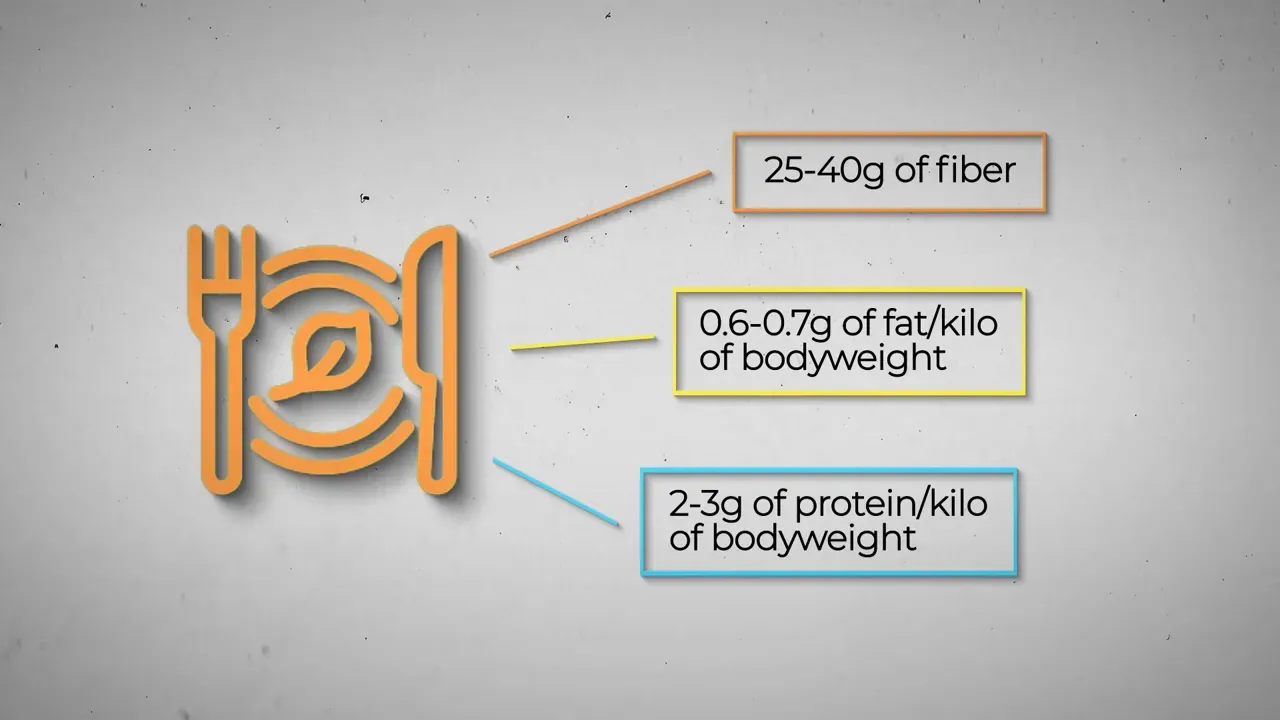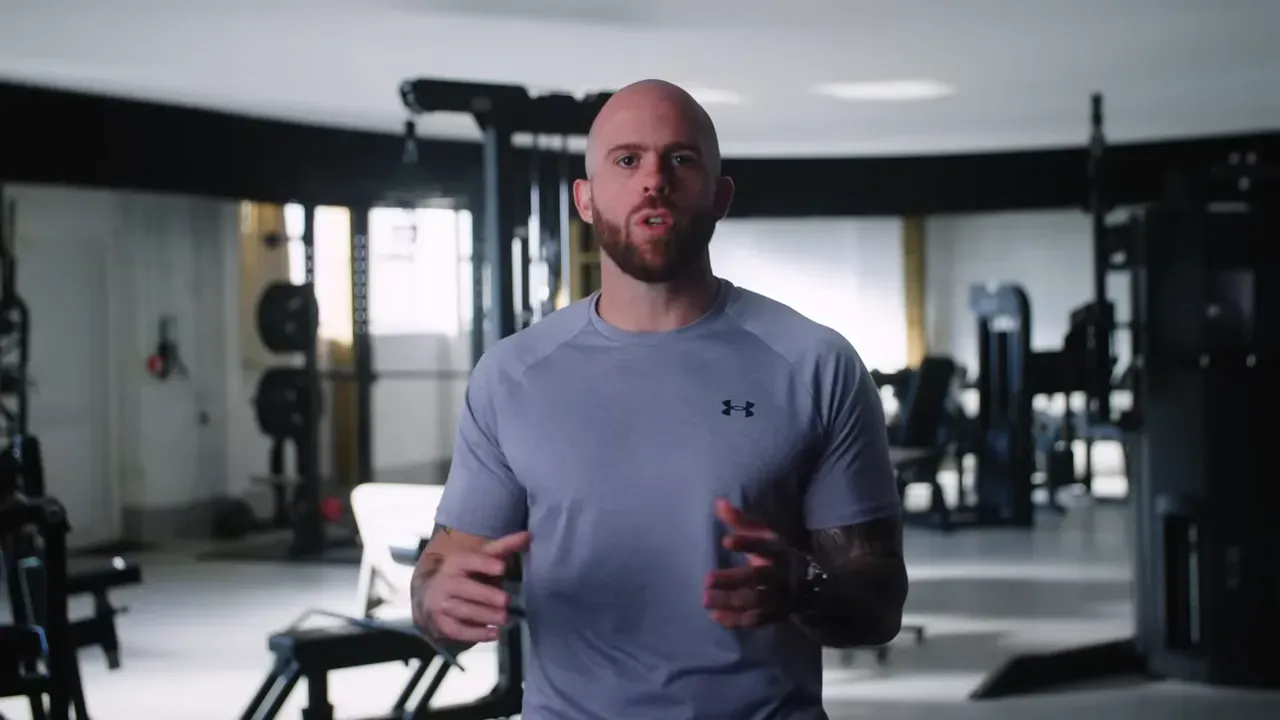How To Gain Muscle & Lose Fat at Once With Science
Leverage the latest science, expert guidance, and practical strategies to gain muscle, lose fat, and transform your body for good.

Key Takeaways
- You can gain muscle while losing fat if you hit ~2–3 g/kg protein and train hard.
- Track maintenance, eat at maintenance, and aim for 12–20 weekly sets per muscle.
- Measure weight trends, circumferences, and gym progress — not just body-fat scans.
Try This Today
✔ Figure out maintenance calories now: track intake and weight for 2 weeks, then set protein to 2 g/kg and hit 12–15 weekly sets per major muscle.
Want To Gain Muscle And Lose Fat At The Same Time?
In this expert review, we analyze, critique, and expand on Dr. Pak's practical guide to body recomposition and the exact habits that help you grow muscle while avoiding fat gain.
What makes this review different?
- Carefully reviewed and fact-checked by experts
- Little-known tips to track progress and avoid common measurement traps
- Complete workout plan inspired by optimizing training volume and intensity while maintaining weight
Why should you listen to us? Our articles are reviewed by exercise scientists with PhDs from top universities and 60+ years of combined training experience. We combine serious academic credentials with decades of practical training experience to give you science-backed advice you can trust. We've published 300+ articles so far.
Keep reading to get a clear, step-by-step plan. You will learn what to eat, how to train, how to track, and how long to commit.
Related:
- Smarter. Smoother. Faster. Be The First To Try The New Dr. Muscle
- A Smarter, Better Way To Build Muscle: The Dr. Muscle Manifesto
- How to Build Muscle Naturally: Expert Guide [In-Depth]
In A Nutshell: Body Recomposition
You can grow muscle and lose fat at the same time if you manage calories, protein, and training well. It works better for beginners and people with higher body fat, but trained lifters can also recomposite with smart choices.
Your core tools are progressive resistance training, high protein (≥2 g/kg), and careful tracking of weight and training performance. Aim to maintain weight while you optimize training and nutrition.
Expect visible change slowly. Think millimeters to centimeters in muscle thickness at first — not a complete makeover in 8 weeks. Stay patient and consistent.
Key Concepts
- Recomposition: Build muscle while losing fat by maintaining or slightly changing calories while optimizing protein and training.
- Intensity Of Effort: Most sets should be 0–2 reps in reserve, with some sets taken to failure for accuracy and stimulus.
- Optimized Volume: Target 12–20 fractional sets per muscle per week (20–30 for priority muscles).
Why Recomposition Works
What Recomposition Really Means
Body recomposition means increasing lean mass while decreasing fat mass. It is not magic. It is a balance of stimulus and substrate. You give your muscles a strong growth signal. You give your body the building blocks it needs. You control calories so fat loss is not favored.

Who Sees It Most Easily
New lifters and people with higher body fat see recomposition most reliably. You get a large raw response to training. You can repurpose energy stored in fat while you build muscle. Protein amplifies this effect.
If you are obese and untrained, a 500–700 kcal deficit with 1.8 g/kg protein and ~10 hard sets per muscle per week will give dramatic fat loss and good muscle gains. That's both health-first and performance smart.
Can Trained Lifters Recompose?
Yes. Trained lifters can recomposite. The effect is smaller and slower. But it happens. The keys are higher protein (often ≥2 g/kg), careful calorie management, and precise training. You must be patient and precise.
Expectations—The Reality Check
Study changes are often measured in millimeters of muscle thickness. Those are real gains. They are not dramatic overnight transformations. You will notice slow visual improvements. Stay with it for months.
How To Make It Happen
Find Maintenance Calories
Start by estimating maintenance. Use a TEE calculator. Be conservative on activity. Then track for 2–4 weeks. Weigh daily under consistent conditions. Use the weekly trend. The trend tells the truth.
Tracking is not optional. Equations are crude. You need real data on your body. Track intake and weight. If weight drifts, adjust by 200–300 kcal. Keep your protein high while you fine-tune calories.
Macros That Work
Set protein to 2–3 g/kg body weight daily. Hit at least 0.66–0.7 g/kg fat. Aim for 25–40 g fiber per day. The rest of your calories come from carbs. They are useful, but not essential for hypertrophy like they are for endurance athletes.
Protein is the main macro for recomposition. It supports muscle protein synthesis and satiety. Eat protein across the day. A protein shake helps on busy days. Creatine monohydrate is recommended as a safe, effective ergogenic aid.

Track Better Than The Scale Alone
Use weight trends, circumference measures, and pictures. Track waist, biceps, chest, thigh. If waist drops or stays the same while limbs grow, you are recompositing. Take photos weekly at the same time and light.
Avoid relying on BIA scales and frequent DEXA. They can mislead you. Use practical metrics: tape measure and gym performance.
Training: The Stimulus That Matters
Lifting is the non-negotiable growth signal. Do the lifting right and the rest falls into place. Aim for most sets at 0–2 RIR. Take some sets to failure to calibrate effort. If you can’t judge RIR reliably, take the last 1–2 sets of key exercises to failure.
One method: if you do four sets of an exercise, take the last two to failure. This does two things: it ensures maximum stimulus, and it calibrates your RIR estimate for other sets.
Intensity And Failure: Smart Use
You do not need to train to failure on every set. Studies show similar hypertrophy when you lean close to failure on some sets and leave a few RIR on others. Use a mix. Perform most sets hard, and make sure a few are bona fide failures.
Weekly Volume Targets
Target 12–20 sets per muscle per week for general growth. For priority muscles, push 20–30 sets. Use fractional sets to account for overlap between movements (e.g., incline press counts mostly for chest, less for triceps).
Don’t obsess over exact numbers. Instead, track progress. If growth stalls, add 1–4 sets per week for the lagging muscle. If fatigue creeps in, reduce volume and reassess.
Exercise Selection And Range Of Motion
Use mostly full ROM. Add some lengthened partials for extra growth in specific ranges. Partials can help overload the stretched position. But full ROM with a good stretch will build muscle effectively.
Frequency And Session Ceilings
Train at least 3 days per week. The ceiling for productive volume per muscle per session appears to be ~11 sets. If you only train a muscle once per week, you will need huge sessions. I prefer upper/lower or push/pull/legs to spread volume and recover better.
Cardio And Activity
Keep daily steps to 8–10k or aim for 150–300 minutes of moderate-high intensity activity weekly. This covers health goals. It does not require relentless stairmaster sessions. Keep cardio reasonable so it does not interfere with recovery.
How Long To Try Recomposition
Commit at least 3 months. Ideally 6 months. Up to a year can work. Recomposition is not an overnight trick. You are not optimizing exclusively for growth or fat loss. If your priority is maximum muscle, step into a small surplus (5–10%). If your priority is fat loss, a 500 kcal deficit is more efficient.
Accept The Tradeoffs
As a natural lifter, recomposition trades off maximum speed of muscle gain for the benefit of staying lean. At worst, you will gain some muscle and not add fat. At best, you grow while getting leaner. Be honest with your goals and choose the right phase when needed.

Smart Bulk-Maintain-Cut Plan
This program is based on the key insight: keep weight roughly stable, hit high protein, and prioritize progressive overload with 12–20 weekly sets per muscle.
Program Overview
- Ideal for: You who want muscle gain without fat gain, and natural trainees.
- Equipment needed: Barbell, dumbbells, rack, bench, pull-up or lat pulldown, cables (optional).
- Structure: 4 days per week (upper/lower) or 6 days (push/pull/legs) depending on time.
Workout
Key rules for every session:
- Warm up well for heavy movements.
- Most sets should land at 0–2 RIR.
- Take the last 1–2 working sets of a main exercise to failure for calibration.
- Progress load or reps weekly when possible.
Day 1 — Upper A
- Barbell Bench Press — 4 sets, 6–8 reps, 2–3 min rest
- Bent-over Row — 3 sets, 6–8 reps, 2 min rest
- Incline Dumbbell Press — 3 sets, 8–10 reps, 90–120 sec rest (last 1–2 sets to failure)
- Pull-ups or Lat Pulldown — 3 sets, 8–12 reps, 90 sec rest
- Face Pulls — 3 sets, 12–15 reps, 60 sec rest
- Barbell Curl — 2 sets, 8–12 reps, 60–90 sec rest
Pro tips:
- Choose a bench press weight that leaves 1–2 RIR for first sets and take final sets to failure for calibration.
- Use explosive but controlled reps on rows; feel the lats.
Day 2 — Lower A
- Back Squat — 4 sets, 6–8 reps, 2–3 min rest
- Romanian Deadlift — 3 sets, 8–10 reps, 2 min rest
- Leg Press — 3 sets, 10–12 reps, 90 sec rest
- Seated or Standing Calf Raise — 3 sets, 12–15 reps, 60 sec rest
- Plank — 3 x 45–90 sec
Pro tips:
- Keep squat depth consistent. Add a set if quads lag behind.
- Use Romanian deadlifts for hamstring lengthened tension.
Day 3 — Rest or Active Recovery
- Walk 8–10k steps or do low-intensity cardio 30–45 min.
- Mobility and foam rolling.
Day 4 — Upper B
- Overhead Press — 4 sets, 6–8 reps
- One-Arm Dumbbell Row — 3 sets, 8–10 reps
- Chest-Supported Incline Row — 3 sets, 10–12 reps
- Incline Cable Fly or Pec Deck — 2–3 sets, 12–15 reps
- Triceps Extension — 3 sets, 10–12 reps (finish one set to failure)
Pro tips:
- Use a full but controlled ROM on the press. Keep elbows slightly forward.
- Finish triceps with a strict set to failure to ensure an intensity fail-safe.
Day 5 — Lower B
- Deadlift Variation (Trap Bar or Conventional) — 3 sets, 4–6 reps
- Bulgarian Split Squat — 3 sets, 8–10 reps per leg
- Hamstring Curl — 3 sets, 10–12 reps
- Leg Extension — 2 sets, 12–15 reps
- Weighted Carry or Farmer Carry — 3 rounds, 40–60 m
Pro tips:
- Use a heavy-ish trap bar deadlift for safe loading. Add weight slowly.
- Use split squats to even out leg imbalances and increase quad volume.
Day 6 — Optional Push/Pull Single-Session Or Rest
- Optional focused work for arms, calves, or weak points. Keep total weekly sets in range.
Notes On Program Execution
- Adjust volume per muscle by adding or subtracting sets across the week, not by changing reps drastically.
- Use fractional sets for overlap: compound lifts count mostly for their prime movers and fractionally for synergists.
- Track load and reps each session. Small gains compound over months.
Want to automate workouts like that and more? Put your progress on autopilot with Dr. Muscle AI. Try Dr. Muscle AI—it's free
Expert Corner: Proven Strategies & Hidden Gems
Practical Applications
- Use A Weight Trend Not Single Weights: Weigh daily and use a 7–14 day average to find true trends. Adjust intake by 200–300 kcal when trend persists.
- High Protein, Not High Drama: Aim for 2 g/kg protein. If you weigh 80 kg, that’s ~160 g protein per day. Split across 3–5 feedings to support synthesis.
- Volume Management: Start at 12 sets per muscle per week. Add 2–4 sets for lagging muscles after 4–6 weeks if growth stalls.
Examples:
- Example 1: A 75 kg trainee targets 150 g protein, eats at maintenance, trains upper/lower 4x per week with 14 chest sets weekly, and gains arm size while slightly reducing waist over 12 weeks.
- Example 2: An obese beginner uses a 600 kcal deficit, 1.8 g/kg protein, and 10 hard sets per muscle weekly and loses 0.5–1 kg per week while improving muscle thickness.
Fact-Check Of Key Points
- "Gaining muscle while losing fat is possible." — True. It’s most pronounced in untrained and higher-body-fat people, and possible but slower in trained lifters when nutrition and training are optimized.
- "Higher protein diets (≥2 g/kg) facilitate recomposition." — Supported. Higher protein helps maintain lean mass and supports MPS during calorie maintenance or mild deficit.
- "You don't need to train to failure every set." — Correct. You can achieve robust hypertrophy when some sets are near failure and others leave 1–3 RIR; use occasional failures to calibrate effort.
- "Frequent DEXA and BIA are poor trackers." — Cautionary truth. Both can vary due to hydration and timing. Use practical measures like tape, photos, and trend weight.
More Little-Known Tips For Recomposition
- Distribute protein evenly across meals — aim for ~0.4 g/kg per feeding across 4 meals to maximize MPS spikes.
- Time carbs around workouts to avoid hunger but don’t chase “anabolic windows.” Pre-workout carbs help performance, not necessarily hypertrophy beyond total intake.
- Use lengthened partials as an accessory in the final phase of your set block to accentuate stretch-mediated growth for stubborn areas.
Common Mistakes With Recomposition & How To Fix Them
- Fix: Over-relying On Weight Scales — Use weekly trend weight, circumferences, and photos instead.
- Fix: Under-eating Protein — Set protein target in grams and log intake. Use a shake on busy days.
- Fix: Too Little Training Volume — Start at 12 sets/muscle and increase if no progress in 4–6 weeks.
- Fix: Training Too Infrequently — Spread volume across 2–3 sessions per muscle per week to hit volume without session ceilings.
My Opinion On Recomposition
I like recomposition for many trainees. It reduces the psychological cost of bulking and cutting. You stay lean and less stressed about diet. For most natural lifters, staying near maintenance while optimizing protein and training is sustainable and effective.
I do not think recomposition is the fastest way to gain muscle. If your priority is pure mass, a small, controlled surplus works better. But many people want both improved physique and low fat. For them, recomposition is an elegant compromise.
I disagree with the idea that recomposition is only for beginners. The effect is smaller in trained lifters, yes. But with meticulous protein intake, volume, and progressive overload, trained lifters can still shift composition over months.
I encourage you to choose based on priorities. If you value steady progress and a stable look, do recomposition. If you want maximal size fast and accept some fat gain, choose a lean bulk. I favor slow lean bulks for those chasing maximal muscle, but recomposition is underused and under-appreciated.
Concluding On Recomposition
You want more muscle and less fat without swinging between big bulks and severe cuts. Recomposition gives a middle path that reduces fat gain and keeps diet sane.
Think of it like renovating a house while living in it. You make careful upgrades without tearing everything down. You improve the structure in place and keep the household running.
More muscle, less fat, and a sustainable diet. You also gain training consistency and better long-term habits.
Want all of this automated? Dr. Muscle AI streamlines calorie tracking, progressive overload, and volume management. It can run your training plan around your day and adjust as you progress. Try Dr. Muscle AI—it's free.
FAQ
Can You Build Muscle While Losing Fat?
Yes. You can build muscle while losing fat, especially if you're untrained or have higher body fat. In trained lifters, this is possible with high protein, careful calorie management, and progressive resistance training.
How Much Protein Do I Need For Recomposition?
You need about 2–3 g/kg body weight per day to support muscle gain during maintenance or a deficit. For an 80 kg person, that means ~160 g protein daily as a practical target.
What Is The Best Calorie Strategy For Recomposition?
The best calorie strategy is to start at maintenance and monitor weight trends for 2–4 weeks. Keep calories near maintenance, and adjust by 200–300 kcal based on persistent weight changes.
How Many Sets Per Week For Muscle Gain?
Aim for 12–20 fractional sets per muscle per week for most muscles, and 20–30 for priority muscles. Use fractional counting when compound lifts involve multiple muscles.
Do I Need To Train To Failure?
No. You don't need to train to failure on every set. Mix near-failure sets (0–2 RIR) with a few sets taken to failure for calibration and stimulus. This balances growth and recovery.
How Long Should I Try Recomposition?
Commit to at least 3 months, ideally 6 months, to assess progress. Recomposition is slow; give it time. If you prefer faster muscle gain, switch to a controlled surplus instead.
Are Body-Fat Scales Useful For Tracking?
Home BIA scales and frequent DEXA scans can mislead due to hydration shifts and measurement error. Use weight trends, circumferences, photos, and training performance as more reliable trackers.
What Supplements Help With Recomposition?
Protein powder can help you reach your protein target. Creatine monohydrate is the most evidence-backed supplement to improve strength and muscle mass. Nothing else is mandatory.
How Much Cardio Should I Do?
Keep daily steps at 8–10k or aim for 150–300 minutes of moderate to high-intensity activity weekly for health. Avoid excessive cardio that impairs recovery from strength training.
Should I BulK Or Recompose If I’m Natural?
If your main goal is maximal muscle, a small surplus (5–10%) over months is optimal. If you want to stay lean while gaining muscle, recomposition at maintenance with high protein and solid training is a better fit.
Final Note
Recomposition works. It is patient work. You follow three pillars: protein, training intensity, and smart tracking. For help automating these choices and keeping your plan consistent, try the app. It will handle programming, progression, and adjustments so you can focus on showing up and training hard. Try Dr. Muscle AI.
We used AI to summarize the video How to REALLY Gain Muscle and Lose Fat at the Same Time (Using Science) while drafting this expert review.

